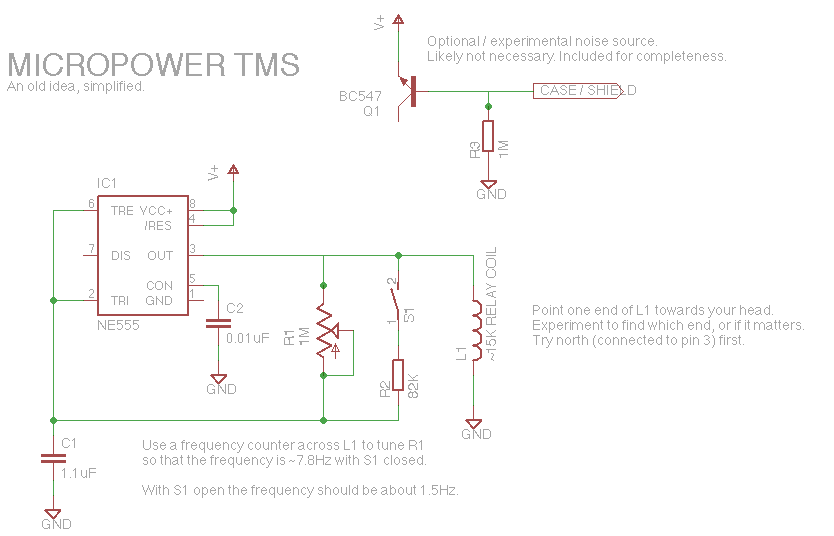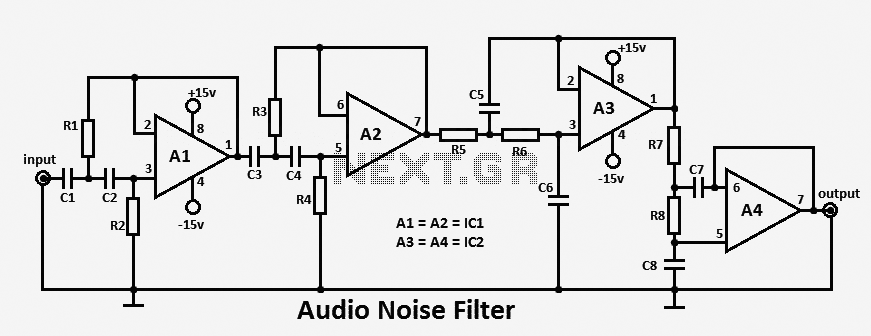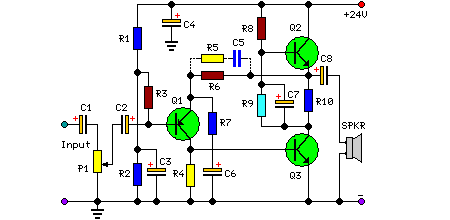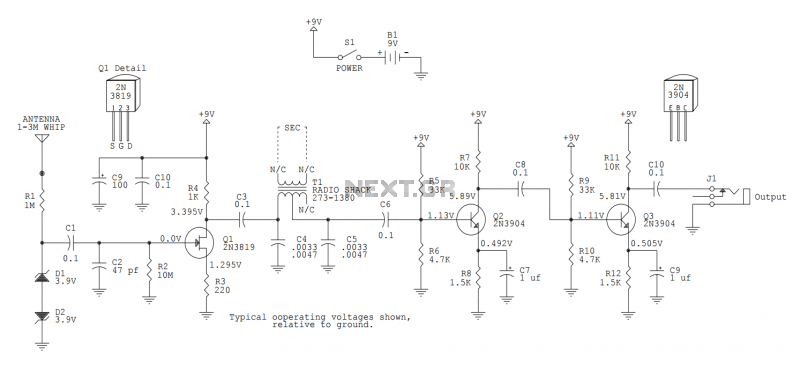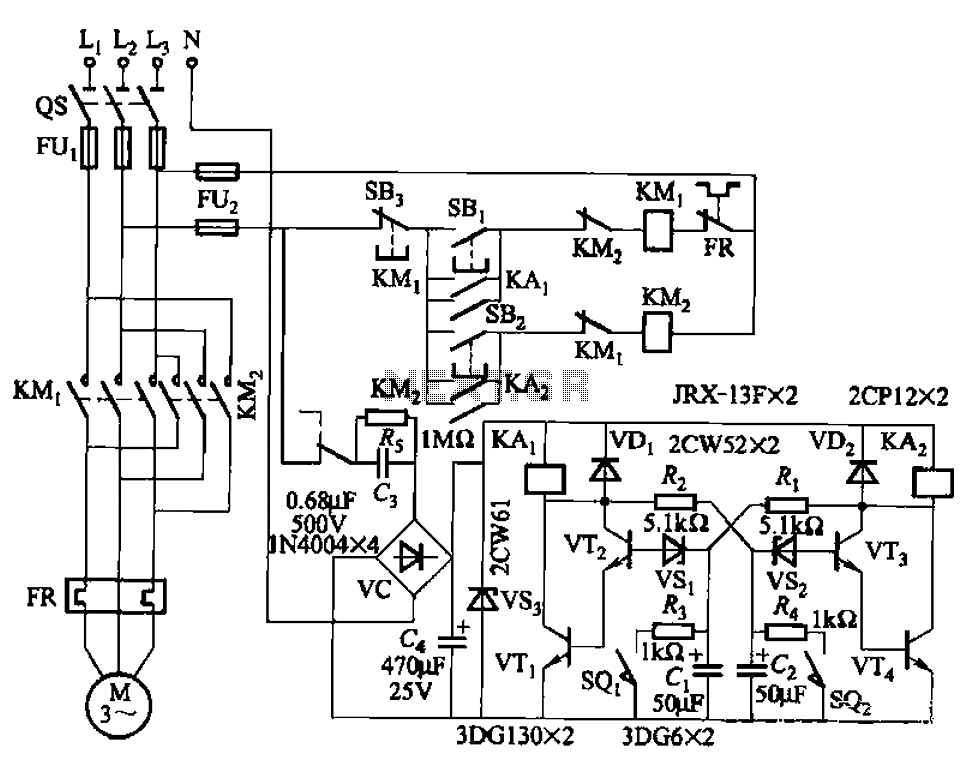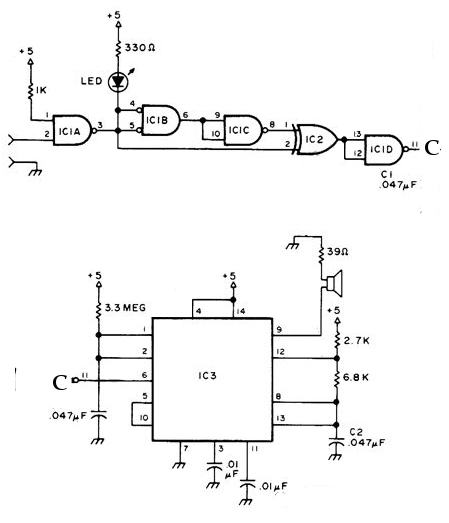
Automatic telephone recording circuit
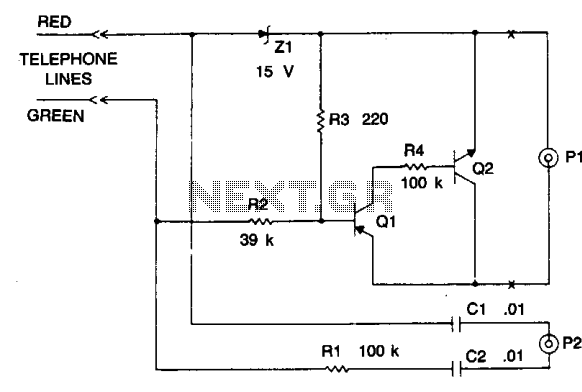
The device is a DC switch that remains normally on due to the forward biasing of Q1 through resistor R3. Q1 clamps Q2 into a forward state by biasing its complementary transistor well into saturation via resistor R4. The DC switch is deactivated by applying a negative voltage that exceeds the Zener voltage of diode D1. This negative voltage is typically around 48 volts, which corresponds to the on-hook value of the phone line. This voltage negates the effect of R3, keeping the circuit in the "off" state. When the phone is taken off the hook, the 48 volts drops to 10 volts, which is below the Zener voltage of D1, allowing R3 to turn the circuit back on.
The audio signal is transmitted through the attenuator resistor R1 and DC isolating capacitors C1 and C2. The device functions as a high-impedance switch that isolates the recording device from the phone line using relatively simple electronic circuitry. It requires no battery, as it derives its operating power from the remote jack, which typically provides 6 volts in most recorders. When clamped to ground, it initiates the operation of the recorder. The unit is compatible with most portable cassette recorders, provided they are equipped with a remote control jack.
The schematic of this device includes several key components that work together to achieve the desired functionality. The core of the circuit is formed by transistors Q1 and Q2, which are configured to operate as switches. Resistor R3 is critical for maintaining the forward bias on Q1, ensuring that the circuit remains active under normal conditions. Resistor R4 is used to ensure that Q2 remains in a saturated state, thus allowing for efficient switching.
The Zener diode D1 plays a crucial role in controlling the switch's operation. When a negative voltage is applied, it effectively overrides the forward bias created by R3, turning off the switch. This feature is essential for preventing unwanted recording when the phone is not in use. The transition from the on-hook state (48 volts) to the off-hook state (10 volts) is managed by the inherent properties of the Zener diode, which allows for a smooth operation of the switch.
The audio path includes attenuator resistor R1, which is designed to limit the signal level to prevent distortion during recording. Capacitors C1 and C2 serve as DC isolation components, allowing the audio signal to pass while blocking any DC voltage that could interfere with the recording process. This configuration ensures that the recording device receives a clean audio signal without any DC offset, enhancing the quality of the recorded material.
Overall, this circuit is designed to be simple yet effective, providing a reliable means of interfacing between a phone line and a recording device without the need for additional power sources. Its compatibility with various portable cassette recorders makes it a versatile solution for audio recording applications.The device is a dc switch that is normally on via the forward biasing of Ql via R3. Ql now clamps Q2 into a forward state by biasing its complement well into a saturated state via R4. The dc switch is turned off via a negative voltage above that of the zener (Dl). This voltage is usually about 48 and is the on-hook value of the phone line. This negative voltage overrides the effect of R3 and keeps the circuit "off." When the phone is off the hook, the 48 volts drops to 10 volts, that is below the zener voltage of Dl and R3 now turns the circuit on. The audio signal is via attenuator resistor Rl and dc isolating capacitors Cl, C2. The device is a high impedance switch that isolates the recording controlled device from the phone line via some relatively simple electronic circuitry. It requires no battery and obtains power for operating via the remote jack that in most recorders is a source of 6 volts.
When clamped to ground it initiates recorder operation. The unit interfaces with most portable cassette recorders providing they contain a remote control jack. 🔗 External reference
The audio signal is transmitted through the attenuator resistor R1 and DC isolating capacitors C1 and C2. The device functions as a high-impedance switch that isolates the recording device from the phone line using relatively simple electronic circuitry. It requires no battery, as it derives its operating power from the remote jack, which typically provides 6 volts in most recorders. When clamped to ground, it initiates the operation of the recorder. The unit is compatible with most portable cassette recorders, provided they are equipped with a remote control jack.
The schematic of this device includes several key components that work together to achieve the desired functionality. The core of the circuit is formed by transistors Q1 and Q2, which are configured to operate as switches. Resistor R3 is critical for maintaining the forward bias on Q1, ensuring that the circuit remains active under normal conditions. Resistor R4 is used to ensure that Q2 remains in a saturated state, thus allowing for efficient switching.
The Zener diode D1 plays a crucial role in controlling the switch's operation. When a negative voltage is applied, it effectively overrides the forward bias created by R3, turning off the switch. This feature is essential for preventing unwanted recording when the phone is not in use. The transition from the on-hook state (48 volts) to the off-hook state (10 volts) is managed by the inherent properties of the Zener diode, which allows for a smooth operation of the switch.
The audio path includes attenuator resistor R1, which is designed to limit the signal level to prevent distortion during recording. Capacitors C1 and C2 serve as DC isolation components, allowing the audio signal to pass while blocking any DC voltage that could interfere with the recording process. This configuration ensures that the recording device receives a clean audio signal without any DC offset, enhancing the quality of the recorded material.
Overall, this circuit is designed to be simple yet effective, providing a reliable means of interfacing between a phone line and a recording device without the need for additional power sources. Its compatibility with various portable cassette recorders makes it a versatile solution for audio recording applications.The device is a dc switch that is normally on via the forward biasing of Ql via R3. Ql now clamps Q2 into a forward state by biasing its complement well into a saturated state via R4. The dc switch is turned off via a negative voltage above that of the zener (Dl). This voltage is usually about 48 and is the on-hook value of the phone line. This negative voltage overrides the effect of R3 and keeps the circuit "off." When the phone is off the hook, the 48 volts drops to 10 volts, that is below the zener voltage of Dl and R3 now turns the circuit on. The audio signal is via attenuator resistor Rl and dc isolating capacitors Cl, C2. The device is a high impedance switch that isolates the recording controlled device from the phone line via some relatively simple electronic circuitry. It requires no battery and obtains power for operating via the remote jack that in most recorders is a source of 6 volts.
When clamped to ground it initiates recorder operation. The unit interfaces with most portable cassette recorders providing they contain a remote control jack. 🔗 External reference
Warning: include(partials/cookie-banner.php): Failed to open stream: Permission denied in /var/www/html/nextgr/view-circuit.php on line 713
Warning: include(): Failed opening 'partials/cookie-banner.php' for inclusion (include_path='.:/usr/share/php') in /var/www/html/nextgr/view-circuit.php on line 713
